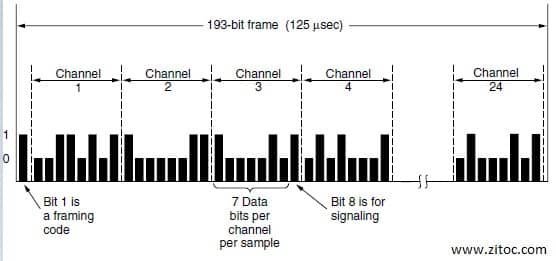Trunks and Multiplexing
Trunks and Multiplexing: The highways of the telephone network are not only much faster than local loops but are distinguished by two other aspects. The heart of the telephone network carries digital and non-analog information. It’s the rhythm, not the voice. This requires scanning in the end office for transmission over long-distance lines. Long-distance lines make thousands, if not millions, of calls at the same time. This exchange in trunks and multiplexing is important for achieving economies of scale, as the installation and maintenance of a high-capacity backbone cost essentially the same amount as the low-capacity mainline connecting two switching offices.
This is achieved by using some trunks and multiplexing versions.
- Digitizing Voice Signals
- Time Division Multiplexing
- SONET/SDH
- Wavelength Division Multiplexing
Digitizing Voice Signals
Digitizing Voice Signals at the beginning of the development of the telephone network, the kernel handled voice calls as analog information. Wavelength Division Multiplexing methods have been used for many years to multiplex voice channels of 4,000 Hz (composed of 3,100 Hz plus guard bands) into larger and larger blocks.
Time Division Multiplexing
PCM-based Time Division Multiplexing is used to transmit multiple voice calls over trunks by sending a sample of each call every 125 μsec. When digital transmission became a viable technology, the ITU (then called CCITT) could not agree on an international standard for the MIC. As a result, various incompatible systems are being used in different countries around the world.

SONET/SDH
At the dawn of fiber optics, each phone company had its own Time Division Multiplexing system. After the collapse of AT & T in 1984, the local telephone companies had to connect to several long-distance service providers, all with different Time Division Multiplexing optical systems. The need for standardization has become obvious. In 1985, Bell-core, RBOC’s research department, began working on a standard called SONET/SDH (Synchronous Optical Network). Design SONET/SDH pursued four main objectives.
First of all, SONET/SDH had to ensure the interaction of the different operators. To achieve this goal, it was necessary to define a common signaling standard for wavelength, duration, frame structure, and other problems.
Secondly, means are needed to integrate digital EE systems. The European Union, Europe, and Japan, all based on 64 kbps PCM channels, but combined in different (and incompatible) ways.
Third, SONET/SDH was supposed to provide a way to multiplex several digital channels. At the time of SONET’s design, the fastest digital operator, widely used in the United States, was T3 at 44,736 Mbit / s. T4 has been defined, but little has been used and nothing has been defined above the speed of T4. Part of SONET’s mission was to continue the hierarchy up to gigabits / s and up. A standard method of multiplexing slower channels in a SONET/SDH channel was also needed.
Fourth, SONNET/SDH must support the operations, administration, and maintenance (OAM) required to administer the network. The previous systems are not very good and can’t do this very well.
Wavelength Division Multiplexing
Frequency division multiplexing, as well as Time Division Multiplexing, is used to exploit the enormous bandwidth of optical fiber channels. This is called Wavelength Division Multiplexing (WDM ). The basic principle of Wavelength Division Multiplexing in fibers is described in the following figure.

Here, four fibers are combined in an optical adder, each having energy having a different wavelength. Four beams are combined into a common fiber for transmission to a remote destination. At the opposite end, the beam is divided into as many fibers as there were at the entrance. Each output fiber contains a short core specially designed to filter all wavelengths minus one. The resulting signals can be sent to the destination or can be combined in different ways for additional multiplex transport.
WDM technology is evolving at a rate that discredits computer technology. WDM was invented in 1990. The first commercial systems had eight channels of 2.5 Gbit / s per channel. In 1998, systems with 40 2.5 Gb / s channels appeared on the market. In 2006, the products were marketed with 192 channels at 10 Gbps and 64 channels at 40 Gbps up to speeds of up to 2.56 Tbps. This bandwidth is sufficient to transfer 80 long DVD movies per second. The channels are also packaged tightly in the fiber with a spacing of 200, 100 or only 50 GHz. Technological demonstrations of companies after obtaining the rights have revealed 10 times more opportunities in the laboratory, but the transition from one laboratory to another usually takes several years. When the number of channels is very large and the wavelengths are separated from each other, the system is called DWDM (Dense WDM).
Read More The Local Loop: Modems, ADSL, and Fiber


